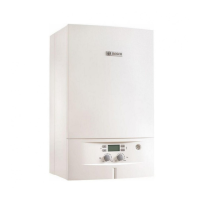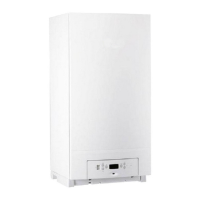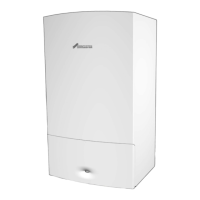26 | COMMISSIONING
Product Name6 720 ... ... (YYYY/MM)
▶ Open all the system and radiator valves.
▶ Turn on the water main stop cock.
Sealed System
1. Monitor the pressure gauge on the control panel of the appliance
2. Slowly fill the system via the external filling link
3. Set the pressure between 1 and 1.5 bar pressure.
Fig. 30 Setting the system pressure
▶ Close the external filling valve
▶ Check the pipe work and connections for leaks and rectify as
necessary
▶ Vent all radiators, retighten when completed.
If the test pressure drops off as a result of the air bleeding:
▶ Top up with domestic cold mains water
▶ Complete pressure test based on the local requirements
Once the pressure test is completed and no leaks are present:
▶ Set correct working pressure
7.3 Water treatment
7.4 Starting the appliance
Fig. 31
[1] Main on/off switch
[2] Diagnostic port (Service engineers only)
[3] DHW button
[4] Heating button
[5] Display
[6] Minus button
[7] Plus button
[8] ok button
[9] Back button
[10] Pressure gauge
[11] Service button
[12] Reset button
[13] Summer/Winter mode button
Switching the appliance on/off:
1. Turn on the mains power supply.
▶ Turn on any external controls.
▶ Set the TRV controls to maximum.
▶ Set the clock or programmer, if fitted, to continuously ON and the
room thermostat to maximum temperature.
2. Switch on the appliance with the ON/OFF switch on the control
panel.
The display lights up and initially shows the appliance temperature.
Fig. 32 Main power switch
NOTICE: Damage to property from overpressure during
pressure tests!
Pressure, control and safety devices may be damaged
by excessive pressure.
▶ After filling the system pressure test to the release
pressure of the safety valve
NOTICE: Damage caused by cracks from thermal shock!
Cracks can occur when toping up a warm heating system
with cold mains water. The boiler could start leaking.
▶ Only fill and top up the heating system when cold
(maximum flow temperature 40 °C)
▶ Comply with the requirements for water quality
Have a fixed connection between mains water supply
and filling point in line with EN 1717. Fit the appropriate
safety device.
NOTICE: Debris from the system can damage the boiler
and reduce efficiency. Failure to comply with the
guidelines for the use of water treatment with the
appliance will invalidate the appliance warranty.
NOTICE:
▶ The quality of the system water must be checked
regularly. Please contact the appliance manufacturer
for further guidance.
▶ The addition of sealing agents to the system water is
not recommended as this can cause problems with
deposits left in the heat exchanger.

